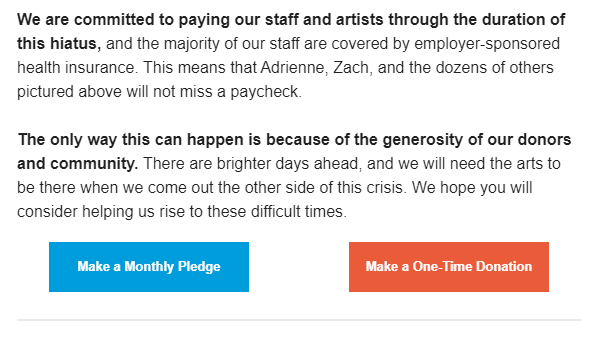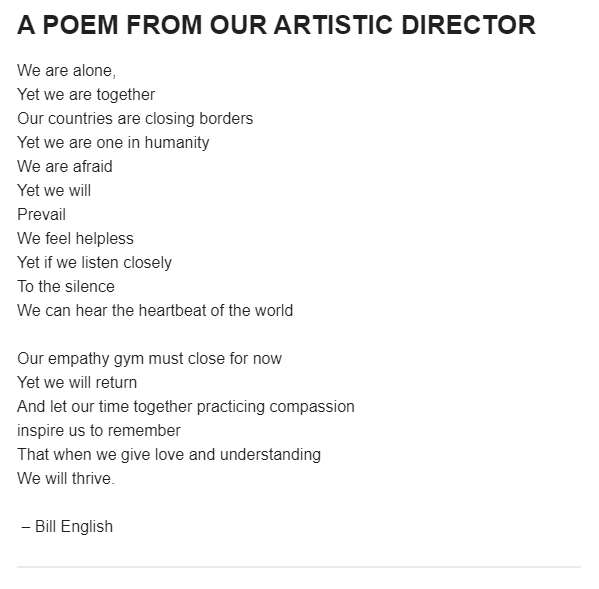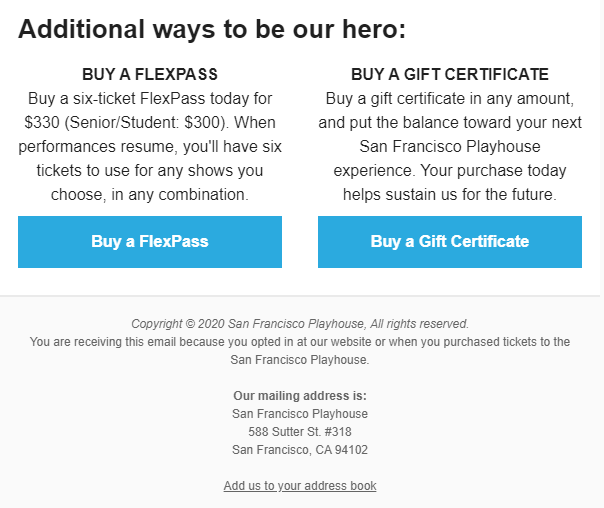 Last week I shared a number of real-life examples from innovative nonprofits taking creative steps to connect meaningfully to their supporters during these trying times. While staying connected, some organizations are succeeding in stepping up both their marketing and fundraising communications to the next level.
Last week I shared a number of real-life examples from innovative nonprofits taking creative steps to connect meaningfully to their supporters during these trying times. While staying connected, some organizations are succeeding in stepping up both their marketing and fundraising communications to the next level.
Sometimes this means virtual events, online conference calls and hang-outs and, yes, asking for the philanthropy needed to respond to urgent needs and stay in business for the longer haul.
I promised today I’d share an example of a straight-up email appeal. Actually, it’s more than an appeal.
Because every communication you have with folks today must be more than business as usual.
It’s got to be empathic.
Let’s face it. All folks are thinking about today is coronavirus. If you ignore this fact, you’ll come across as out of touch and even insensitive. So begin every communication with some acknowledgement of what people are going through. Not just you. Them.
Check in with people and ask them how they’re doing. This is actually always a good way to begin. We do it more in our personal lives (oddly, particularly with strangers). You ask the clerk at the counter “How’s it going?” You leave the store saying “Have a nice day.” In fact, one of the hallmarks of a culture of philanthropy is you’ll find staff always asking each other “How can I help you today?” [See “Fundraising Bright Spots”]
Silver lining of this pandemic? Rediscover the power of empathy. Take this opportunity to connect the dots between the problem you lay out and the solution with which the donor can be helpful. This is solid, basic fundraising – the way it should always be practiced but too often is not. Use this opportunity to be better.
It’s got to be innovative.
Remember, this is not ‘business as usual.’ Already every nonprofit and their dog are sending out messages related to this crisis. What will get your messages to stand out? Lots of things come to mind, including great subject headlines, compelling images and graphics, engaging stories and an authentic tone. All the basics apply.
Practice solid fundraising, of course, but try to add in a little bit of something extra. Novelty. Fun. Inspiration. Prayer. Social action. Whatever is best suited to your particular brand and community.
Silver lining of this pandemic? Many of your familiar, tired strategies were probably due for a change anyway. This is an opportunity to reject the status quo, develop new skills and consider fresh initiatives that may, ultimately, serve you far better than the ones you’ve been using.
TIME TO SHARE AN EMAIL EXAMPLE: APPEAL PLUS
Subject headline
A Message from the Playhouse
Preview pane
How we will make it through these difficult times. View in browser. Support Us. Thousands of artists and staff members rely on the performing arts…




How Would You Evaluate this Email?
I’ll take you through the process I use to audit a communication like this one. This is why you’re enrolled in ‘Clairification School’ – to learn how to do these things without my help, right? [By the way, if this is one of your free articles, and you’re not yet enrolled, there’s no time like the present. I’ve got lots more stuff coming to help you through this crisis. Your support means a lot, as it makes it possible for me to continue helping you – plus oodles of nonprofits without budgets for coaching, classes and consultation. Okay… ‘pledge drive’ is now over!]
8-Point Communication Audit Process
Subject headline and preview pane:
- Would you open that email?
- If yes, why?
- If no, why?
Body of email:
- What looks good about it?
- What looks not so good?
- Would it inspire you to take the requested action?
- If so, why?
- If not, why not?
I encourage you to read the above example carefully. Think through the answers to these questions yourself because you’ll likely get more out of this if you do.
Seriously, I mean it. We learn best by doing.
This may help: Take three minutes and jot down your answers to the first three questions on a piece of paper or your screen. I want to know if what was in the subject headline (“A Message from the Playhouse”) or the email preview pane (“How will we make it through these difficult times. View in browser. Support Us. Thousands of artists and staff members rely on the performing arts…”) would have caused you to open the email or hit ‘delete.’
Okay.
Now take a look at the email in its entirety and jot down your answers to questions 4 – 8. There is no one right answer. Your perception is as valid as mine. We won’t always agree. I’ve worked with a lot of nonprofits, over nearly four decades, so generally have an idea of what works/doesn’t work. But… every organization is different. So feel free to disagree – and tell me why in the comments section below.
Ready to know my answers?
Would you open that email? Yes or no? Why?
You’d likely open it if you’re already a constituent of this organization. Especially today, because you’ll want to know if they’re still open and how they’re handling things during this pandemic. I opened it, because I’m both a subscriber and donor.
Could it have been more compelling? Yes. I’d prefer to see a more direct subject line that makes it abundantly clear what the reader will find inside. Often if you look at the first several paragraphs of your email you’ll find a line that would make a better header. In this case, I’d borrow from the second paragraph: “Doing everything possible to keep the Playhouse ‘empathy gym’ up and running.” This lets the reader know they’ll find a list of different, proactive steps – things the Playhouse is doing and things supporters can do. This is not just a ‘message.’ It’s not just an ‘appeal.’ It’s information about a variety of things supporters will care about: status of performances; commitment to performers and staff; variety of ways readers can help, and why theater is still relevant during times like these.
What looks good about it?
The photo at the top is priceless. Here images quickly convey — better than words – the real human beings behind the scenes of this theatrical endeavor. These are the folks who will suffer if the show doesn’t go on.
The intro message is uplifting. No screaming the sky is falling. Instead, a matter-of-fact recognition of the facts on the ground, with the hopeful statement: “our community will persist… and we will be back.” Reassuring words for distinctly un-reassuring times.
People are given a direct link to easily check in on the status of upcoming performances. For folks who hold tickets, this is useful. And, if there’s ever a time to consider how your organization might be useful, this is it! Take a look at your own website, and see if you could add some useful, regularly updated information to your home page.
Donors are reminded they can be heroes. This is always a good idea. People yearn to be helpful. They are wondering what they can do to be of service now – even if they’re not frontline responders. For this particular audience, keeping the arts alive sounds like a terrific way to be useful.
There are several donation links — ‘contribute;’ ‘make a monthly pledge’ and ‘make a one-time donation’ – all leading to a dedicated landing page asking folks to help pay artists and staff during this hiatus so the arts will be there when we emerge from this crisis. The monthly option is a particularly good one right now, because those who’ve already given can add an extra monthly gift – just until this pandemic passes. It might be a nice idea to suggest this more explicitly.
I like the inspiring poem. To me this is a nice, distinctive, human touch, and perfect for an artistic company. Really connects the Playhouse to its ‘brand.’ Empathy, empathy, empathy.
Folks who prefer to make a purchase rather than a donation are offered this option. The idea of a ‘flex pass’ – where ticket buyers can choose their specific plays later on – makes total sense right now. Similarly, purchasing a ‘gift certificate’ for later use helps obviate the fear of buying tickets now for a show that may not happen. Other local retail businesses are doing the same for those who want to keep their favorite services, stores and restaurants open.
There’s contact/mailing information for those who’d prefer to give offline. Always a good idea. Though more and more folks do business digitally, there are still those who don’t feel comfortable sending money this way. Don’t leave them out!
What looks not so good?
The preview pane is a bit wonky. The part with “View in browser. Support Us” is a vestige of what shows up at the top of the email. Sometimes you have to play with your email to make things show up as you wish in your preview pane. So… be sure to work with your marketing and/or IT folks to get this done appropriately. And always test your emails to see how they display in a reader’s inbox using common inboxes (e.g., Gmail and Outlook) and both desktop and mobile devices.
It’s too long. As lovely as this email is, it covers a bit too much ground. When people have to read ‘below the scroll,’ they’ll often give up before they get to the action you most want them to take. This could easily have been separated into three emails sent on different days:
Remember, most people either click on your email on the day it’s received or they delete it. When you only send one email, you’re going to miss a lot of people. Why not expand the chances your message will be read by spreading your material out over a period of time? Don’t worry people will feel inundated. Not right now. People are craving connection. Especially from organizations they already support.
There are too many action items. When you ask folks to do more than one thing at a time this can lead to what’s known as ‘analysis paralysis.’ People aren’t sure what their best choice is. They don’t know what you most want them to do. So… they put your appeal aside for later. And later never comes.
Would it inspire you to take the requested action? Why? Why not?
Many supporters were inspired, and they received an outpouring of gifts in the hours immediately following the e-mailing. So, yes, it worked. I’m not sure how long it worked for, however. Usually the action dies down within the first 24 – 48 hours of sending out an e-appeal. (And, sorry, haven’t been able to get an update on how many folks subscribed or bought gift certificates. If I find out, I’ll update this article.) Again, I’d recommend if you’re sending e-appeals now you spread them out over several days. Just like you do with end-of-calendar-year email campaigns.
And now… on to the always important follow-through.
TIME TO SHARE A THANK YOU FOR OUR TIMES
Hi there,
Just a quick note to say thank you – I noticed you just responded to our bad news of the COVID-19 cancellation with a donation. I know you already got an automated response, but I wanted to make sure you knew right away that your gift is very much appreciated. It’s folks like you that will help keep us afloat in these uncertain times, and see us through to the end of this storm.
In my (FaceTime) meeting with Bill today, he reminded me that we are all a big family, and that families come together in times of crisis. Thank you for being part of our family and contributing to the future of the San Francisco Playhouse. With your help, we are confident that we will weather this crisis and come out stronger because of it.
Don’t hesitate to reach out if you need anything at all, even if it’s non-Playhouse related. (I am in good health and have a car!) If you need a hand, please ask. What a reminder that we are all human, and all in this together.
Warmly,
Tiiu Eva Rebane
Director of Audience and Donor Relations
Work Cell: 415.866.8907
NOTE: The boldface is my addition, because I want to call out what I believe to be the most important elements in this emailed expression of gratitude.
This is an A+ thank you – and let me tell you why.
This is a human, not an automated, response.
Be very careful with automated responses right now. They can be huge time-savers in ordinary times, assuring your donors receive prompt thank you’s. But even in good times I advocate sending an additional, more personal thank you a bit later. This can be a mailed letter that includes some insert material (perhaps including a token gift), a welcome package for new donors, a simple hand-written note or, even better, a phone call.
NOTE: Review any automated responses you have set to go out reminding folks of upcoming events, including volunteer opportunities. I just received one reminding me I’d be attending an in-person event next Sunday evening. Really? I expect they’ll cancel or hold it virtually, and they’re planning an email to specifically let folks know. However… the reminder that came today looked a bit out of touch. Even though people will understand and forgive right now, this is never ideal.
This extends the gratitude beyond a one-time transaction.
Here the writer makes it clear this is an additional thank you because, right now, it’s important the donor knows how very much their support is appreciated. It’s not business as usual. The donor didn’t have to make a second gift. But, the fact they did was noticed. Donors, like most people, appreciate being noticed. Plus, there’s research showing effective gratitude must be repeated. The initial shot of ‘feel good’ dopamine folks get from giving doesn’t last long (about as long as eating a single piece of chocolate). To sustain their ‘warm glow’ requires an ongoing gratitude practice. So… send more sweets for your sweeties!
This makes clear the donor is considered part of the family.
Donor communications should never be just about the money. Because gifts are never just about the money. They’re about outcomes the donor cherishes, and values they want to express. So thanking them for being kind, caring and demonstrably generous is important. It makes supporters feel all warm and fuzzy. And this makes them want to continue sticking with you. Just like a family member!
This goes the extra mile.
The most special part of this email is the offer to be there if the donor needs help. I often say the nonprofit-donor relationship is symbiotic. You need them. They need you. This has never been truer, and this closing paragraph is a real gem. It’s always a good idea to think about ways to be of service to your supporters, and even spoil them a bit. And the best part about this thank you message? I know Tiiu and know she means it! Her warmth and authenticity comes across. Beyond offering that shot of dopamine, she’s offering comfort in a time when that’s desperately needed.
There’s contact info and a useful information link.
Always make sure donors can reach you easily. And never miss an opportunity to drive folks to your website where any number of good things can be accomplished:
- They can find news and updates
- They can sign up for your email list
- They can read a story or view a video and become further inspired
- They can volunteer or attend an event (today, those would be virtual)
- They can make an additional donation
- They can share info from your website with their networks – thereby extending your reach and potential audiences.
How will you and your nonprofit make it through these difficult times?
 Two words:
Two words:
EMPATHY.
INNOVATION.
This email and thank you exhibit both of these qualities. And they’re what are most needed in today’s topsy-turvy world.
I’d like you to think of them as your newly essential fundraising and communication strategies. Apply them to everything you do for the duration of this uncertain, challenging time. Do not send out an email, a newsletter, an appeal, a social media post, a thank you or anything else without first running them through the screen of these two approaches to connecting meaningfully with your constituents.
Peace and good health to all,

Photo by cottonbro from Pexels






Oh Claire…. you continue to make this 85-year old retired fundraiser Smile!! These are very much comments and suggestions I have made over many past years…. thanks for being there for those in the trenches, today!!!
So happy to have made you smile! Thanks for letting me know. Makes me smile too.